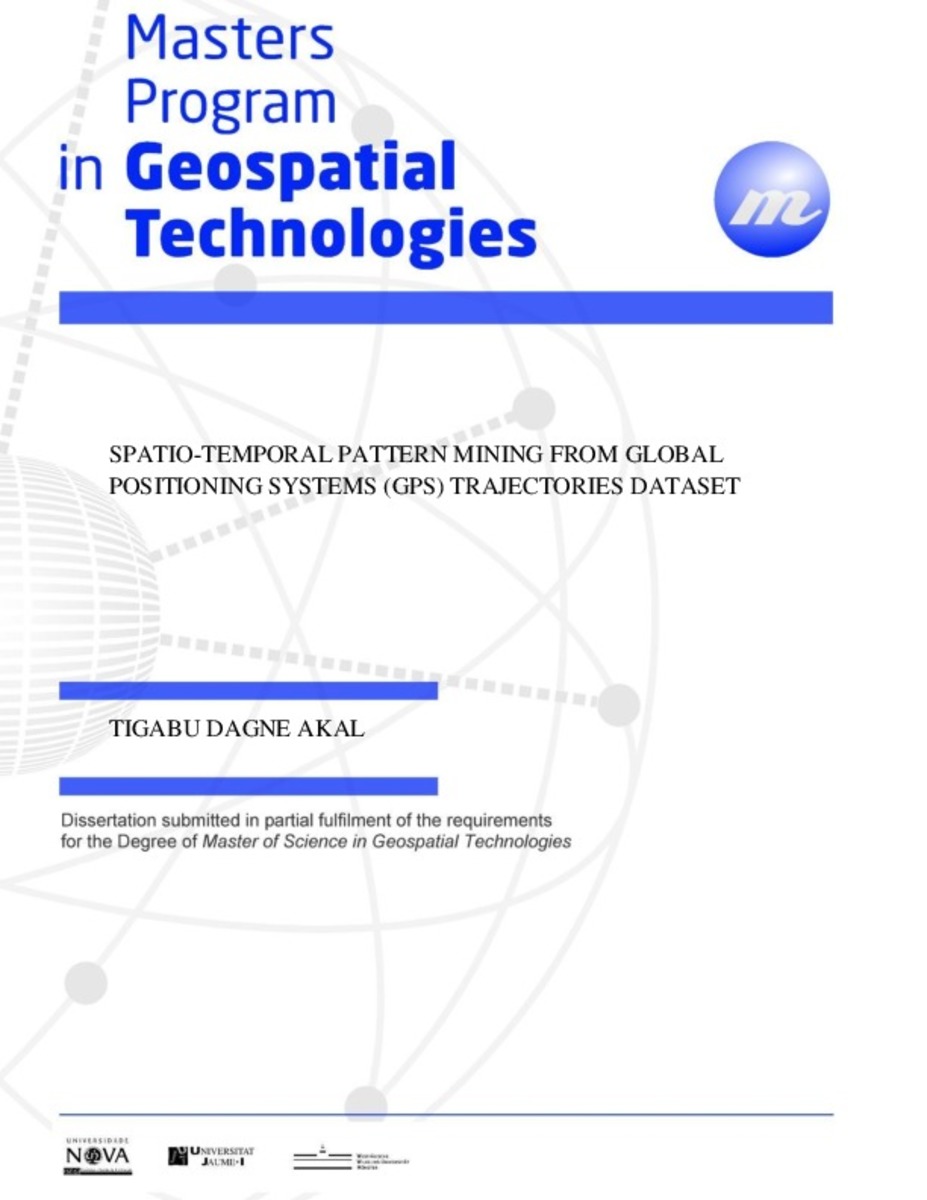Mostrar el registro sencillo del ítem
Spatio-temporal pattern mining from global positioning systems (GPS) trajectories dataset
| dc.contributor | Belmonte Fernández, Óscar | |
| dc.contributor | Pebesma, Edzer | |
| dc.contributor | Henriques, Roberto | |
| dc.contributor.author | Akal, Tigabu Dagne | |
| dc.contributor.other | Universitat Jaume I. Departament de Llenguatges i Sistemes Informàtics | |
| dc.date.accessioned | 2016-04-22T07:55:41Z | |
| dc.date.available | 2016-04-22T07:55:41Z | |
| dc.date.issued | 2015-08 | |
| dc.identifier.uri | http://hdl.handle.net/10234/158921 | |
| dc.description | Treball final de Màster Universitari Erasmus Mundus en Tecnologia Geoespacial. Codi: SIW013. Curs acadèmic 2014-2015 | ca_CA |
| dc.description.abstract | The increasing frequency of use location-acquisition technology like the Global Positioning System is leading to the collection of large spatio-temporal datasets. The prospect of discovering usable knowledge about movement behavior, which encourages for the discovery of interesting relationships and characteristics users that may exist implicitly in spatial databases. Therefore spatial data mining is emerging as a novel area of research. In this study, the experiments were conducted following the Knowledge Discovery in Database process model. The Knowledge Discovery in Database process model starts from selection of the datasets. The GPS trajectory dataset for this research collected from Microsoft Research Asia Geolife project. After taking the data, it has been preprocessed. The major preprocessing activities include: Fill in missed values and remove outliers; Resolve inconsistencies, integration of data that contains both labeled and unlabeled datasets, Dimensionality reduction, size reduction and data transformation activity like discretization tasks were done for this study. A total of 4,273 trajectory dataset are used for training the models. For validating the performance of the selected model a separate 1,018 records are used as a testing set. For building a spatiotemporal model of this study the K-nearest Neighbors (KNN), decision tree and Bayes algorithms have been tasted as supervised approach. The model that was created using 10-fold cross validation with K value 11 and other default parameter values showed the best classification accuracy. The model has a prediction accuracy of 98.5% on the training datasets and 93.12% on the test dataset to classify the new instances as bike, bus, car, subway, train and walk classes. The findings of this study have shown that the spatiotemporal data mining methods help to classify user mobility transportation modes. Future research directions are forwarded to come up an applicable system in the area of the study. | ca_CA |
| dc.format.extent | 63 p. | ca_CA |
| dc.format.mimetype | application/pdf | ca_CA |
| dc.language.iso | eng | ca_CA |
| dc.publisher | Universitat Jaume I | ca_CA |
| dc.rights | Attribution-NonCommercial-NoDerivs 4.0 Spain | * |
| dc.rights.uri | http://creativecommons.org/licenses/by-nc-nd/4.0/ | * |
| dc.subject | Màster Universitari Erasmus Mundus en Tecnologia Geoespacial | ca_CA |
| dc.subject | Erasmus Mundus University Master's Degree in Geospatial Technologies | ca_CA |
| dc.subject | Máster Universitario Erasmus Mundus en Tecnología Geoespacial | ca_CA |
| dc.subject | accuracy | ca_CA |
| dc.subject | Cross Validation | ca_CA |
| dc.subject | data mining | ca_CA |
| dc.subject | Geo-life | ca_CA |
| dc.subject | GPS | ca_CA |
| dc.subject | K-Nearest-Neighbor | ca_CA |
| dc.subject | trajectory | ca_CA |
| dc.subject | Transportation modes | ca_CA |
| dc.subject | WEKA | ca_CA |
| dc.title | Spatio-temporal pattern mining from global positioning systems (GPS) trajectories dataset | ca_CA |
| dc.type | info:eu-repo/semantics/masterThesis | ca_CA |
| dc.educationLevel | Estudios de Postgrado | ca_CA |
| dc.rights.accessRights | info:eu-repo/semantics/openAccess | ca_CA |
Ficheros en el ítem
Este ítem aparece en la(s) siguiente(s) colección(ones)
-
TFM: Màster Universitari Erasmus Mundus en Tecnologia Geoespacial [79]
SIW013; SIK013








